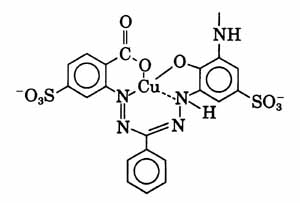Is Remazol Blue BB dye anionic or cationic, and what is the closest formula for this dye?
Is Remazol Blue BB dye anionic or cationic, and what is the closest formula for this dye?
Name: Gizem
—ADVERTISEMENTS—
Books about the
Chemistry of Dyes

Linda Knutson's
Synthetic Dyes for Natural Fibers
by Heinrich Zollinger
Color Chemistry: Synthesis, Properties, and Applications of Organic Dyes and Pigments
The Chemistry and Application of Dyes
edited by David R. Waring
and Geoffrey Hallas
Country or region: Turkey
Message: Hello. I'm a masters student in Ankara University/Turkey. I'm working on biological dye treatment with "Remazol Blue BB (RB 220)" dye, but couldn't find much about this dye. I want to ask, is Remazol Blue BB dye anionic or cationic, and what is the closest formula for this dye?
Remazol Blue BB appears to be widely available from dye manufacturers that are listed online, though not from smaller-scale retailers, with the generic name Colour Index reactive blue 220, and either one or the other of two CAS numbers, 128416-19-3 or 90341-71-2.
Remazol Blue BB is listed in two charts on my page, "About Vinyl Sulfone Fiber Reactive Dyes". Its chemical name is
cuprate(4-), [4,5-dihydro-4-[[8-hydroxy-7-[[2-hydroxy-5-methoxy-4-[[2- (sulfooxy)ethyl]sulfonyl]phenyl]azo]-6-sulfo-2-naphthalenyl]azo]-5-oxo-1-(4-sulfophenyl)-1H- pyrazole-3-carboxylato(6-)]-, sodium.
A molecular formula for this dye that was supplied on the AliBaba website by Shijiazhuang He Dye Chem is C22H15CuN4Na2O12S3, with a molecular weight of 733.10; however, even at a glance, the number of sulfur atoms indicated by the chemical name is obviously greater than are included in this formula, and the same source also indicates that the dye is insoluble in water, which seems quite unlikely, both because that would severely limit its usefulness as a textile dye, and because the sulfonyl groups mentioned in the formula are used in order to allow a dye to be soluble in water.
The chromophore of Remazol Blue BB includes a copper formazan complex, as listed in the book "Industrial dyes: chemistry, properties, applications", by Klaus Hunger. Other formazan dyes listed there include Colour Index reactive green 15 and Colour Index reactive blues 70, 83, 84, 104, 157, 160, 182, 202, 209, 212, 216, 218, 221, 226, 235, 260, and 263. You will probably want to search the scientific literature for all references you can find to any of these related dyes. The structure of the copper formazan choromophore should be similar to the one given by Dr. Steve Mihok, on his page "Blue Dyes", for another copper formazan dye, reactive blue 163 (CIbacron Blue F-R), though the reactive portion, which is not shown, would be quite different, since reactive blue 163 is an aminofluorotriazine dye:
Posted: Friday - September 30, 2011 at 11:26 AM
Follow this blog on twitter here.
Quick Links
- All About Dyes & Dyeing Top -
- Top of this blog -
- FAQ -
- The Dye Forum -
- How to Tie Dye - How to Batik -
- Books - Toys - Plants -
- Top of this blog -
- FAQ -
- The Dye Forum -
- How to Tie Dye - How to Batik -
- Books - Toys - Plants -
More in this category:
- -
Statistics
Total entries in this blog:
Total entries in this category:
Published On: Aug 29, 2012 02:49 PM
Total entries in this category:
Published On: Aug 29, 2012 02:49 PM


